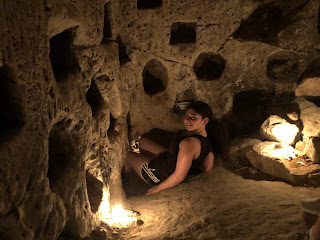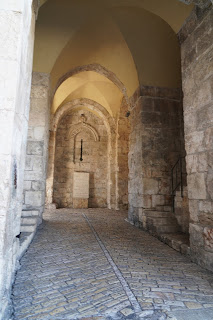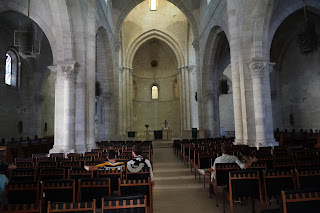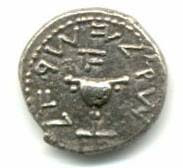Tel Maresha is not just a National Park in Israel, its also an active archeological site.
A settlement active at the time of the Maccabees, in the 3rd Century BCE, it was abandoned shorty thereafter.
The inhabitants cut caves into the soft limestone were used as basements of houses by the inhabitants and as workshops and importantly as columbariums. Most caves at the Tel are still unexplored, unexcavated, and many are still not even discovered yet, even after over 80 caves have been discovered at the Tel.
We first visited the main Columbarium Cave, which has been fully excavated.
We entered the underground cave through its arch leading on a descent downward.
To say it is impressively large inside would be an understatement:
What's a Columbarium? In this case its not how the word is normally defined.
In this case, it's an underground place to raise pigeons.
Each pigeon-hole was hand-cut into the rock, and yes, pigeons still live there.
Can you see the pigeons in the picture? Click to embiggen:
Pigeons create baby pigeons and pigeon poop, both important items in the ancient world - food and fertilizer.
There are over 20,000 pigeon holes in this main columbarium cave. Other pigeon holes, numbering in the thousands can be found in other caves.
Some let their photo be taken out by the exit of the cave.
Then we got to participate in an Archeological Dig.
Down into a cave we went.
The rooms were smaller, as the "floor" while seeming solid wasn't the floor at all, instead it was packed ancient dirt that had fallen into the cave over the centuries.
Now pretty deep underground in a cave system undergoing excavation, we got our trowels, buckets and after some instruction we began to dig into the ancient dirt, moving rocks and rubble out of the way.
It wasn't long before we began finding things. We were keenly aware that we were the first people to see these items in over 2.300 years.
Abby found a large fragment of an ancient plate:
All of us continued to find animal bones, pottery shards - both large and small. Leah and Abby discovered an small stairway leading down to an entry to another cave room and entrance, right where the archeologist figured it would be, which is why she had them dig there. That new found room will be excavated in time.
The dig felt much too short, and we could have spent days in there digging our way through history. If you're visiting in Israel it's a must-do.
Later, while sifting through the dirt brought up in the buckets, Leah found something amazing.
She saw a round small object and pointed it out. It was a bronze ring or possible jewelry adornment, washed off, it looked like this:
No one had seen it for over 2,300 years.
The archeologist was quite excited by the find and had it placed in the important finds bucket that is secured in the dig lab each day rather than in the loose pottery buckets that are less impressive and less prone to scavengers and site looters.
Yes, that was a real highlight of the trip.
Next the archeologist took us into we headed to a completely unexcavated cave.
Lit only by candles it was not a space for the claustrophobic.
Getting in took some wiggling.
There were tight tunnels to go through. We all went in single file with the archeologist at the head of the line and I was the caboose, very little room on any side.
This worked out well. Unfortunately one of the guys doing the dig had a panic attack underground due to claustrophobia. Natasha doing her therapist thing kept him calm enough to move and I was able to guide him back out to the outside where he calmed down. I then went back in and caught up to the group, following the trail of candles left as markers so I didn't head into any side passages.
Then we got pretty deep in to an area that widened out and we sat down to look around.
As one would expect, pigeon holes were cut in the walls.
There was an amazing structure made out of stone bricks but we were warned not to touch it or try to go behind it as there seemed to be a passage there but they didn't know if it was stable at this point or where it led to yet.
Then we headed out up an ancient stairway to the cave exit.
Seeing a cave fully excavated, participating in excavating one, and going through a cave yet to be touched were all amazing experiences the whole family thoroughly enjoyed. The experience of such closeness to ancient history was awesome.
To say it was an incredible and amazing morning was an understatement.




















































